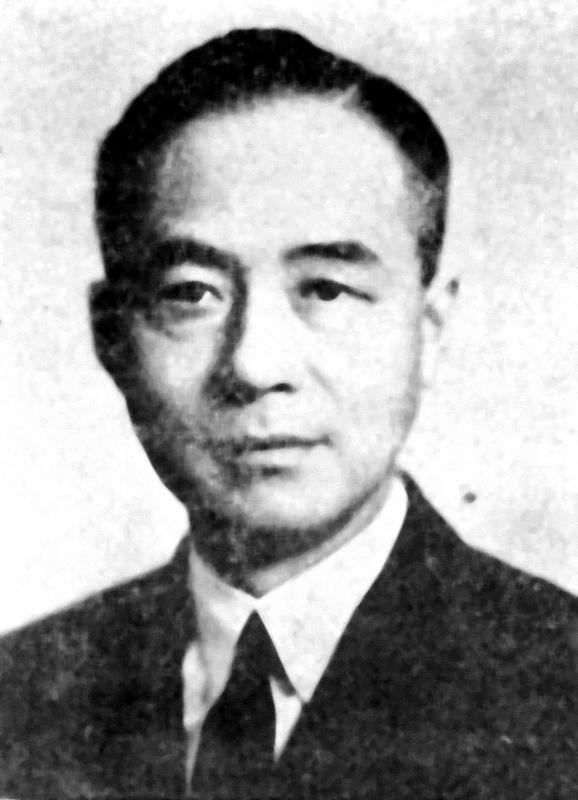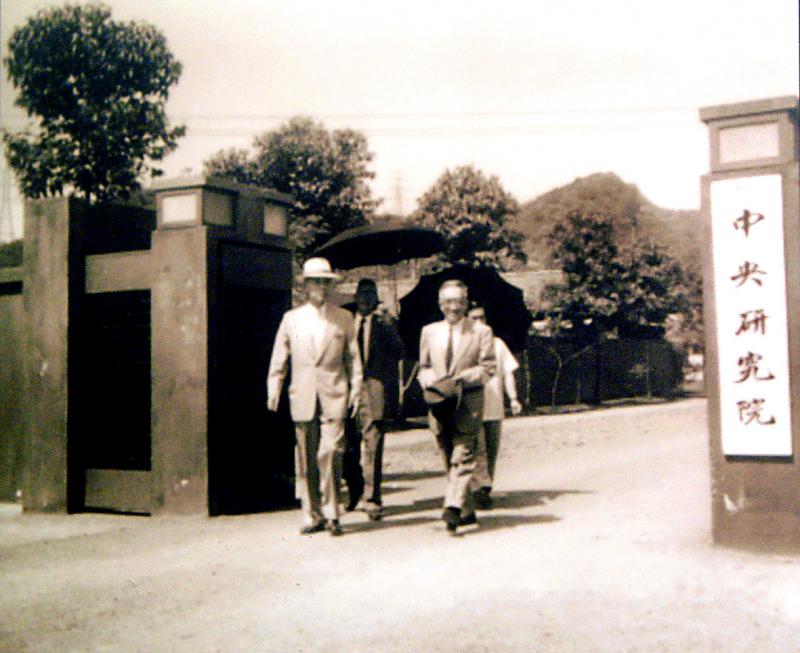June 6 to June 12
The staff at Academia Sinica’s Institute of Physics loaded their materials and equipment into wooden crates during the day, only to remove them at night. Even though all 14 institutes had agreed in December 1948 to move from Nanjing to Taiwan as the Chinese Communist Party (CCP) gained the upper hand in the Chinese Civil War, most of them did not want to leave.
So they stalled.

Photo courtesy of Wikimedia Commons
Institute of Sociology head Tao Meng-he (陶孟和) was the most outspoken — he detested the Chinese Nationalist Party (KMT) and was willing to give the communists a chance if they could run the country better.
Others simply didn’t want to go to Taiwan — rumors told of a destitute, overcrowded place with hostile locals and only banana peels to eat. But they were mostly weary of more than a decade of displacement due to war, and still held hope that something would come out of the KMT-CCP talks in April 1949.
Then-Academia Sinica president Chu Chia-hua (朱家驊) tried to move what they could to a port in Shanghai, but talks soon fell through and the communists seized Nanjing. In the end, only the Institute of Mathematics and Institute of History and Philology made it to Taiwan; the rest were absorbed into the CCP’s Chinese Academy of Sciences, of which Tao was appointed deputy president. Out of the newly-appointed 81 research fellows, only nine crossed the Taiwan Strait.

Photo courtesy of Academia Sinica
Chu refused to shut down the institution despite a grave lack of resources and government support, and finally reopened it with just one institute in December 1954 in Taipei’s Nangang District (南港). His tumultuous tenure is detailed in the book Chu Chia-hua and Academia Sinica (朱家驊與中央研究院) by Huang Li-an (黃麗安).
He abruptly resigned in 1957, and was succeeded by noted scholar Hu Shih (胡適). The research academy celebrates its 94th anniversary this week, dating to its establishment in Nanjing on June 8, 1928.
RELOCATION WOES

Photo courtesy of Academia Sinica
The Second Sino-Japanese War was raging when Chu was reluctantly appointed interim head of Academia Sinica in 1940, upon the death of founding president Tsai Yuan-pei (蔡元培). The cash-strapped academy faced personnel shortages, and Chu urgently needed to move several institutes with valuable artifacts away from Kunming, where the war was intensifying.
It was a huge ordeal that almost failed, but Chu pulled through, working closely with Institute of History and Philology founder and head Fu Ssu-nien (傅斯年).
Academia Sinica returned to Nanjing after World War II, but the situation was soon looking dire for the KMT again as a communist victory loomed. Chu delivered an optimistic speech during the academy’s celebration of its 20th anniversary and appointment of its first research fellows, but he and other institute heads privately discussed yet another relocation.

Photo courtesy of Academia Sinica
After obtaining the necessary funding, Chu allowed each institute to decide their own fate. It was a unanimous decision to leave, and on Dec. 19, 1948, Taiwan was officially approved as the final destination via Guangxi and Guangdong provinces.
All ongoing construction was halted immediately, and each institute was ordered to build large crates out of any timber they had on hand. Meanwhile, Chu sent agents to make arrangements with academic institutions along the way and in Taiwan, including National Taiwan University (NTU). Artifacts from the Institute of Mathematics and Institute of History and Philology were shipped to Taiwan first along with National Palace Museum treasures.
NTU was in disarray at that time, going through seven presidents in three years. After much persuading by Chu and other government bigwigs, Fu begrudgingly went ahead and took over the school to prepare for the academy’s arrival.
However, the unwillingness of many researchers, plus the communists’ quick capture of Nanjing and Shanghai, ensured that the remaining 12 institutes remained in China.
REBUILDING IN TAIWAN
Chu’s effort to revive Academia Sinica in Taiwan was extremely arduous. Morale was low, there was virtually no funding and overseas researchers expressed little interest in joining. With the government focused on military affairs to retake China, Chu’s political clout waned.
There wasn’t even housing for the staff of the two institutes that relocated to Taiwan in early 1949, and at first they slept in NTU classrooms. The Institute of History and Philology was set up in a shabby, leaky warehouse in today’s Yangmei (楊梅) District in Taoyuan, and the staff stayed in rural houses rented from residents.
Institute of Mathematics head Chiang Li-fu (姜立夫) quit in June 1949 and accepted a position in Guangdong, never arriving in Taiwan. He told Chu there was no point having a research institute if there was no money to do research. Both Chiang and Fu advised Chu to shut down the academy, and a dismayed Chu wrote a furious letter to Fu in response.
After failing to receive government funding, Chu turned his efforts overseas, obtaining the support of Hu Shih (胡適), who was in the US, as well as various American diplomats and academics. Representatives from the Rockefeller Foundation and Japanese academics visited the Yangmei warehouse, and upon seeing the conditions, pledged to help out as well.
However, inflation soared in Taiwan and Chu desperately needed the government to step in. In November 1952, he tendered a 2,000-word resignation letter, noting that further inaction would not only cause Taiwan’s academics to lag behind, it would deprive its ability to preserve its historical artifacts and national culture. He finally got the money in 1953.
After much deliberation, Chu decided on Nangang’s Jiuzhuang area (舊莊), whose surrounding mountains provided protection in case of a communist air strike. It was a quiet, secluded place well-suited for academic research that wasn’t too far from downtown Taipei, and there was plenty of room for future expansion. The land was acquired from local farmers, many of whom were offered jobs in the complex.
The first phase of construction was completed in July 1954, and the Institute of History and Philology moved there in December. The Institute of Botany was the first to be revived due to the importance of agriculture to Taiwan’s economy.
There was still a long road to go, however, and Chu repeatedly clashed with officials in the following years. Still facing financial woes, Chu used funds originally earmarked for Chinese students to study abroad. This was approved by the government at first, but later drew the ire of then-president Chiang Kai-shek (蔣介石), leading to Chu’s resignation in 1957.
Taiwan in Time, a column about Taiwan’s history that is published every Sunday, spotlights important or interesting events around the nation that either have anniversaries this week or are tied to current events.

This is the year that the demographic crisis will begin to impact people’s lives. This will create pressures on treatment and hiring of foreigners. Regardless of whatever technological breakthroughs happen, the real value will come from digesting and productively applying existing technologies in new and creative ways. INTRODUCING BASIC SERVICES BREAKDOWNS At some point soon, we will begin to witness a breakdown in basic services. Initially, it will be limited and sporadic, but the frequency and newsworthiness of the incidents will only continue to accelerate dramatically in the coming years. Here in central Taiwan, many basic services are severely understaffed, and

Jan. 5 to Jan. 11 Of the more than 3,000km of sugar railway that once criss-crossed central and southern Taiwan, just 16.1km remain in operation today. By the time Dafydd Fell began photographing the network in earnest in 1994, it was already well past its heyday. The system had been significantly cut back, leaving behind abandoned stations, rusting rolling stock and crumbling facilities. This reduction continued during the five years of his documentation, adding urgency to his task. As passenger services had already ceased by then, Fell had to wait for the sugarcane harvest season each year, which typically ran from

It is a soulful folk song, filled with feeling and history: A love-stricken young man tells God about his hopes and dreams of happiness. Generations of Uighurs, the Turkic ethnic minority in China’s Xinjiang region, have played it at parties and weddings. But today, if they download it, play it or share it online, they risk ending up in prison. Besh pede, a popular Uighur folk ballad, is among dozens of Uighur-language songs that have been deemed “problematic” by Xinjiang authorities, according to a recording of a meeting held by police and other local officials in the historic city of Kashgar in

It’s a good thing that 2025 is over. Yes, I fully expect we will look back on the year with nostalgia, once we have experienced this year and 2027. Traditionally at New Years much discourse is devoted to discussing what happened the previous year. Let’s have a look at what didn’t happen. Many bad things did not happen. The People’s Republic of China (PRC) did not attack Taiwan. We didn’t have a massive, destructive earthquake or drought. We didn’t have a major human pandemic. No widespread unemployment or other destructive social events. Nothing serious was done about Taiwan’s swelling birth rate catastrophe.